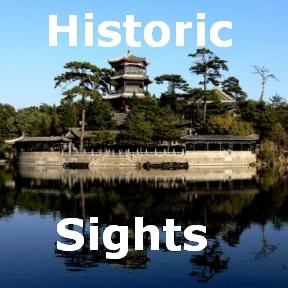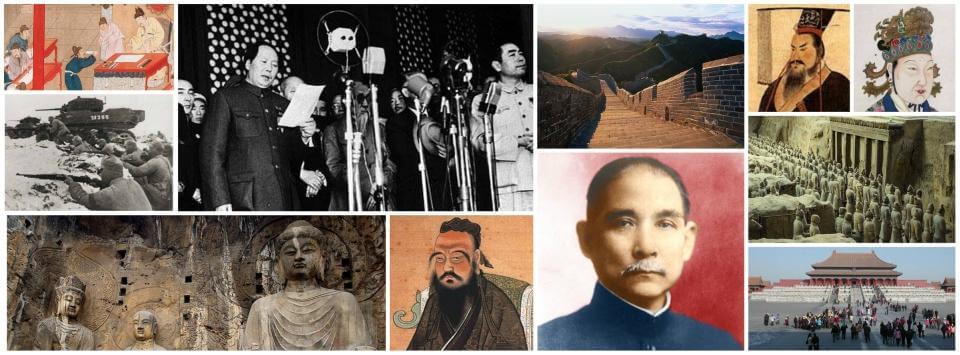
Forbidden City
The information contained here are subject to change. Chinese History Digest is not responsible or liable if any changes should occur. You can also check the official website of the Palace Museum for the latest information.
Opening Hours
April - October: 8.30am - 5pm
November - March: 8.30am - 4.30pm
The Forbidden City is closed on Mondays (except during Chinese holidays).
Entrance Ticket Prices
April - October: 60 yuan
November - March: 40 yuan
Treasure Gallery: + 10 yuan
Clock and Watch Gallery: + 10 yuan
Tickets only available up to 1 hour before closing time!
The Forbidden City was the official residence for 14 emperors of the Ming dynasty and 10 emperors of the Qing dynasty from 1420 until 1912. Its name derives from the fact that visitors were back then only allowed to enter with special permission of the emperor. It is nowadays also known as the Palace Museum whereas most Chinese people refer to it as Gugong (former palace). As one of the many historic sights in China that are listed on the UNESCO world heritage list, it is an absolute must-see for travelers that are interested in the culture and history of the country. Annual visitor numbers that almost reach 20 million (19.3 million visitors in 2019) make the Forbidden City in Beijing one of the most visited tourist sights in the world.
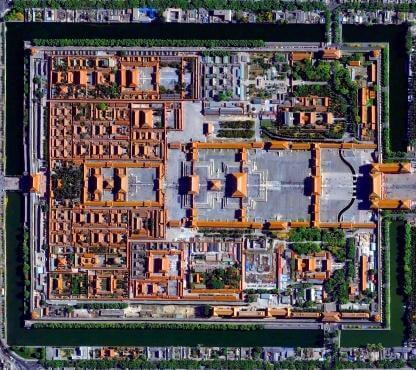 Beijing's Forbidden City as seen from the airThe Forbidden City was built between the years 1407 and 1420 by a workforce of about a million laborers. The following year, the Ming emperor then moved his capital from Nanjing to Beijing. As the world's largest palace complex, the Forbidden City occupies a large rectangular area of 74 hectares just north of Tiananmen Square right at the heart of China's capital Beijing. The palace compound with its more than 8700 rooms is surrounded by a high wall, four corner towers and a wide moat. To get a first impression of the sheer size of this former palace, you might want to take a look at this large-scale map!
Beijing's Forbidden City as seen from the airThe Forbidden City was built between the years 1407 and 1420 by a workforce of about a million laborers. The following year, the Ming emperor then moved his capital from Nanjing to Beijing. As the world's largest palace complex, the Forbidden City occupies a large rectangular area of 74 hectares just north of Tiananmen Square right at the heart of China's capital Beijing. The palace compound with its more than 8700 rooms is surrounded by a high wall, four corner towers and a wide moat. To get a first impression of the sheer size of this former palace, you might want to take a look at this large-scale map!
The palace compound is divided into two parts, an Outer Court (or Front Court) and an Inner Court (or Back Palace). The Outer Court in the south of the compound was the place from where the country was governed and where ceremonial acts were performed. It is made up of a central area where the main halls and gates stand along an axis from north to south and the East Wing and West Wing area to each side. The emperor and his family resided within the Inner Court in the northern section of the Forbidden City. That's also where the day-to-day affairs of state were handled. China's last emperor Puyi was driven out of the Inner Court in 1924, more than a decade after the fall of the Qing dynasty!
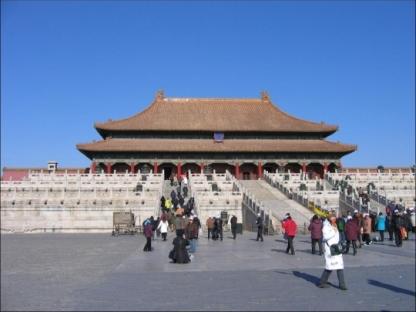 Taihedian - the Hall of Supreme HarmonyAfter entering the Forbidden City through the Meridian Gate, visitors will see a large square that is traversed by the Inner Golden Water River. The river is crossed by five bridges of which the central bridge was only used by the emperor. Behind it at the other side of the square stands the Gate of Supreme Harmony (Taihemen). This is where emperors' wedding ceremonies were mostly held. Behind the Gate of Supreme Harmony is another even larger square. Three halls stand at the center of it on top of a three-tiered white marble terrace.
Taihedian - the Hall of Supreme HarmonyAfter entering the Forbidden City through the Meridian Gate, visitors will see a large square that is traversed by the Inner Golden Water River. The river is crossed by five bridges of which the central bridge was only used by the emperor. Behind it at the other side of the square stands the Gate of Supreme Harmony (Taihemen). This is where emperors' wedding ceremonies were mostly held. Behind the Gate of Supreme Harmony is another even larger square. Three halls stand at the center of it on top of a three-tiered white marble terrace.
The first and grandest of them is the Hall of Supreme Harmony (Taihedian), the largest timber structure ever assembled in China. This majestic hall was the center of imperial power during the Ming dynasty when the emperor held court there. Large celebrations and ceremonies were also performed here such as emperors' birthdays, Winter Solstice and Chinese New Year festivities, wedding ceremonies and the dispatch of generals to war.
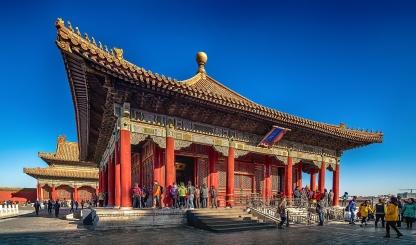 Zhonghedian - The Hall of Central HarmonyThe Hall of Central Harmony (Zhonghedian) and the Hall of Preserving Harmony (Baohedian) are the other two halls that stand on the white marble terrace behind the Hall of Supreme Harmony. The three halls are collectively known as the Three Great Halls of the Outer Court. The emperors used the smaller Hall of Central Harmony as a place to consult with ministers and officials and as a preparation and resting place before holding ceremonies at the Hall of Supreme Harmony. The Hall of Preserving Harmony was where the Palace Examination (the final stage of the imperial examination system) was held during the Qing dynasty. It was also used for imperial banquets and the rehearsal of ceremonies.
Zhonghedian - The Hall of Central HarmonyThe Hall of Central Harmony (Zhonghedian) and the Hall of Preserving Harmony (Baohedian) are the other two halls that stand on the white marble terrace behind the Hall of Supreme Harmony. The three halls are collectively known as the Three Great Halls of the Outer Court. The emperors used the smaller Hall of Central Harmony as a place to consult with ministers and officials and as a preparation and resting place before holding ceremonies at the Hall of Supreme Harmony. The Hall of Preserving Harmony was where the Palace Examination (the final stage of the imperial examination system) was held during the Qing dynasty. It was also used for imperial banquets and the rehearsal of ceremonies.
The Gate of Heavenly Purity (Qianqingmen) further north of the Hall of Preserving Harmony marks the entrance to the Inner Court of the Forbidden City. Behind that gate you will see the Palace of Heavenly Purity (Qianqinggong). This is where the emperors lived and handled their affairs of state during the time of the Ming dynasty and early Qing dynasty (the first two Qing emperors). After the death of an emperor during the Qing dynasty, the Palace of Heavenly Purity was also used as the place where the emperor's coffin would lie in state for the first few days of mourning.
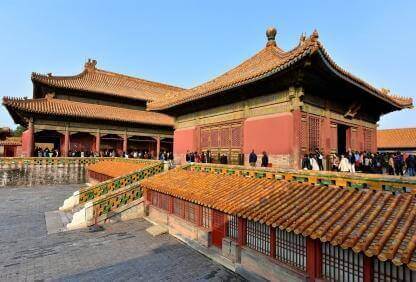 the Forbidden City's Hall of Celestial and Terrestrial Union (front) & Palace of Earthly Tranquility (back)The Hall of Celestial and Terrestrial Union (Jiaotaidian) and the Palace of Earthly Tranquility (Kunninggong) are the other two main palaces of the Inner Court. The Hall of Celestial and Terrestrial Union to the north of the Palace of Heavenly Purity was mainly used by the empress to receive worship and congratulations and to celebrate her birthdays. During the Ming dynasty, the empress lived at the Palace of Earthly Tranquility right behind the Hall of Celestial and Terrestrial Union. Later during the Qing dynasty, that palace was used as an altar to worship Shamanic deities that the Manchu rulers believed in. After the wedding ceremonies of the Kangxi Emperor, Tongzhi Emperor and Guangxu Emperor, the Palace of Earthly Tranquility was used as the nuptial chamber by the newly-wed emperor and empress for a few days. When visiting the Palace of Earthly Tranquility, you will see the interior in the same decor as it was for the grand wedding of the Guangxu Emperor.
the Forbidden City's Hall of Celestial and Terrestrial Union (front) & Palace of Earthly Tranquility (back)The Hall of Celestial and Terrestrial Union (Jiaotaidian) and the Palace of Earthly Tranquility (Kunninggong) are the other two main palaces of the Inner Court. The Hall of Celestial and Terrestrial Union to the north of the Palace of Heavenly Purity was mainly used by the empress to receive worship and congratulations and to celebrate her birthdays. During the Ming dynasty, the empress lived at the Palace of Earthly Tranquility right behind the Hall of Celestial and Terrestrial Union. Later during the Qing dynasty, that palace was used as an altar to worship Shamanic deities that the Manchu rulers believed in. After the wedding ceremonies of the Kangxi Emperor, Tongzhi Emperor and Guangxu Emperor, the Palace of Earthly Tranquility was used as the nuptial chamber by the newly-wed emperor and empress for a few days. When visiting the Palace of Earthly Tranquility, you will see the interior in the same decor as it was for the grand wedding of the Guangxu Emperor.
Passing through the Gate of Earthly Tranquility (Kunningmen) further north, you will reach the Imperial Garden (Yuhuayuan). Layed out in a rectangular fashion with pavilions marking the four corners (symbolizing the four seasons), this typical Chinese imperial garden was used by the imperial family as a private retreat. The Hall of Imperial Peace (Qin'andian) at the center of the garden was used to address the Taoist God of Water in prayer to ask for protection from fire. Before exiting the Forbidden City through the Gate of Divine Might (Shenwumen) in the north now, don't forget to visit the structures in the East and West Wing.
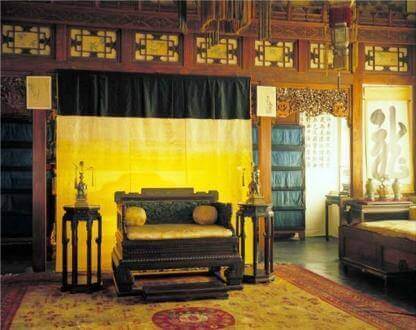 Empress Dowager Cixi handled state affairs while sitting behind this curtain at the Hall of Mental CultivationIn the Inner Court area of the West Wing, you will find palaces and halls that served as a residential area for the emperor's wives and concubines. These are the Hall of Mental Cultivation (Yangxindian), Palace of Compassion and Tranquility (Cininggong), Palace of Longevity and Good Health (Shoukanggong) and the Six Western Palaces (Xiliugong). The Hall of Mental Cultivation has primarily found fame in Chinese history as the place from where Empress Dowager Cixi ruled the country from behind a yellow curtain. The Palace of Compassion and Tranquility is made up of the Hall of Compassion and Tranquility, the Grand Hall for Worshipping Buddha and the Garden of Compassion and Tranquility. The Hall of Compassion and Tranquility now serves as the sculpture hall of the Palace Museum where you will find more than 400 rare cultural treasures on display.
Empress Dowager Cixi handled state affairs while sitting behind this curtain at the Hall of Mental CultivationIn the Inner Court area of the West Wing, you will find palaces and halls that served as a residential area for the emperor's wives and concubines. These are the Hall of Mental Cultivation (Yangxindian), Palace of Compassion and Tranquility (Cininggong), Palace of Longevity and Good Health (Shoukanggong) and the Six Western Palaces (Xiliugong). The Hall of Mental Cultivation has primarily found fame in Chinese history as the place from where Empress Dowager Cixi ruled the country from behind a yellow curtain. The Palace of Compassion and Tranquility is made up of the Hall of Compassion and Tranquility, the Grand Hall for Worshipping Buddha and the Garden of Compassion and Tranquility. The Hall of Compassion and Tranquility now serves as the sculpture hall of the Palace Museum where you will find more than 400 rare cultural treasures on display.
The Palace of Longevity and Good Health became the residence of empress dowagers after the death of their emperor husbands. The reigning emperor's wives and concubines lived at the Six Western Palaces. These are the Palace of Eternal Longevity (Yongshougong), Palace of the Queen Consort (Yikungong), Palace for Gathering Elegance (Chuxiugong), Hall of the Supreme Pole (Taijidian), Palace of Eternal Spring (Changchungong) and Palace of Universal Happiness (Xianfugong). Empress Xiaoqinxian (who later became known as Empress Dowager Cixi) lived at the Palace for Gathering Elegance for a long time until the death of her husband, the Xianfeng Emperor, in 1861.
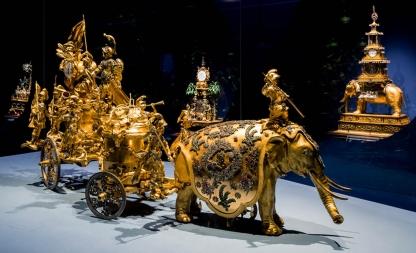 exhibits at the Clock and Watch Gallery of the Palace Museum inside the Hall for Ancestry WorshipIn the Inner Court area of the East Wing, you will find the Hall for Ancestry Worship (Fengxiandian), the Palace of Tranquil Longevity (Ningshougong), the Treasure Gallery (Zhenbaoguan), the Qianlong Garden and the Six Eastern Palaces (Dongliugong). In dynastic times, the Hall for Ancestry Worship was used by the members of the imperial household to worship their ancestors. It now serves as the Clock and Watch Gallery of the Palace Museum where you can see more than 200 timepieces from the 18th century on exhibit.
exhibits at the Clock and Watch Gallery of the Palace Museum inside the Hall for Ancestry WorshipIn the Inner Court area of the East Wing, you will find the Hall for Ancestry Worship (Fengxiandian), the Palace of Tranquil Longevity (Ningshougong), the Treasure Gallery (Zhenbaoguan), the Qianlong Garden and the Six Eastern Palaces (Dongliugong). In dynastic times, the Hall for Ancestry Worship was used by the members of the imperial household to worship their ancestors. It now serves as the Clock and Watch Gallery of the Palace Museum where you can see more than 200 timepieces from the 18th century on exhibit.
The two main buildings of the Palace of Tranquil Longevity complex are now the Palace Museum's Exhibition Hall of Fine Arts. You can see more than 100,000 paintings on display there from as far back as the Jin dynasty. Three halls make up the Treasure Gallery, the Hall of Spiritual Cultivation (Yangxingdian), the Hall of Joyful Longevity (Leshoutang) and the Belvedere of Well-Nourished Harmony (Yihexuan). Visitors will now see all kinds of precious cultural treasures exhibited there such as jade and other precious-stone items, furnishings, tea services, imperial robes and items made of gold or silver.
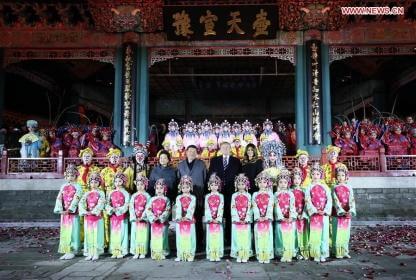 Xi Jinping, Donald Trump and other VIP's after watching a Beijing Opera performance at the Pavilion of Pleasant Sounds in 2017To the east of the Treasure Gallery lies the Palace of Scenery and Happiness (Jingfugong) as well as a recreational and entertainment area where the imperial family watched theater and opera performances at the Pavilion of Pleasant Sounds (Changyinge), the Hall for Viewing Opera (Yueshilou) and the Theater Pavilion (Banxilou). The area to the west of the Treasure Gallery is occupied by the Qianlong Garden. From the Pavilion of Expecting Good Omen (Fuwangge) inside the garden, you will have the best overview of its four different scenes.
Xi Jinping, Donald Trump and other VIP's after watching a Beijing Opera performance at the Pavilion of Pleasant Sounds in 2017To the east of the Treasure Gallery lies the Palace of Scenery and Happiness (Jingfugong) as well as a recreational and entertainment area where the imperial family watched theater and opera performances at the Pavilion of Pleasant Sounds (Changyinge), the Hall for Viewing Opera (Yueshilou) and the Theater Pavilion (Banxilou). The area to the west of the Treasure Gallery is occupied by the Qianlong Garden. From the Pavilion of Expecting Good Omen (Fuwangge) inside the garden, you will have the best overview of its four different scenes.
The Six Eastern Palaces where the imperial concubines once resided are the Palace of Great Benevolence (Jingrengong), Palace of Celestial Favour (Chengqiangong), Palace of Eternal Harmony (Yonghegong), Palace of Great Brilliance (Jingyanggong), Palace of Purity (Zhongcuigong) and Palace of Lasting Happiness (Yanxigong). Most of these buildings now serve as exhibition halls. Whereas more than 15,000 bronze items are shown at the Palace of Eternal Harmony and Palace of Celestial Favour, gold and silver treasures can be seen at the Palace of Great Brilliance and precious jade items at the Palace of Purity.
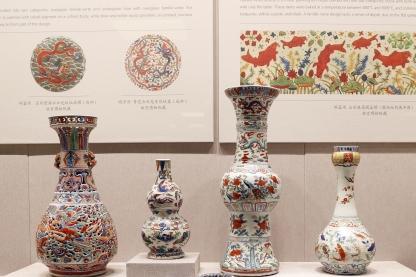 Ming Dynasty ceramics at the Palace Museum's Pottery GalleryThe Hall of Martial Valor (Wuyingdian) and the Hall of Embodied Treasures (Baoyunlou) are the major structures in the Front Court of the West Wing and the Hall of Literary Glory (Wenhuadian) is their counterpart in the East Wing. The Hall of Martial Valor is currently the Pottery Gallery of the Palace Museum with about 400 exquisite pottery treasures on display. The Hall of Embodied Treasures is used as an exhibition hall that showcases the history and historical evolution of the Palace Museum. Its architecture is in the style of the Republic of China since it was only built in 1915 at the former place of the Palace of Universal Safety (Xi'an'angong) which had been destroyed by fire. The Hall of Literary Glory in the East Wing now serves as a Painting Gallery. In imperial China, it had been used at various times as the palace of the crown prince, the emperor's rest hall, the office of the Grand Secretariat and for speeches of the emperor (to his ministers) about the Four Books and Five Classics.
Ming Dynasty ceramics at the Palace Museum's Pottery GalleryThe Hall of Martial Valor (Wuyingdian) and the Hall of Embodied Treasures (Baoyunlou) are the major structures in the Front Court of the West Wing and the Hall of Literary Glory (Wenhuadian) is their counterpart in the East Wing. The Hall of Martial Valor is currently the Pottery Gallery of the Palace Museum with about 400 exquisite pottery treasures on display. The Hall of Embodied Treasures is used as an exhibition hall that showcases the history and historical evolution of the Palace Museum. Its architecture is in the style of the Republic of China since it was only built in 1915 at the former place of the Palace of Universal Safety (Xi'an'angong) which had been destroyed by fire. The Hall of Literary Glory in the East Wing now serves as a Painting Gallery. In imperial China, it had been used at various times as the palace of the crown prince, the emperor's rest hall, the office of the Grand Secretariat and for speeches of the emperor (to his ministers) about the Four Books and Five Classics.
Visitors from all over the world are drawn to the Forbidden City to admire its splendid architecture and all the immense treasures that are assembled and displayed within its walls. All visitors must enter through the Meridian Gate (Wumen) in the south of the compound and leave through either the Gate of Divine Prowess (Shenwumen) or East Prosperity Gate (Donghuamen). The Meridian Gate is the second gate behind the Tiananmen Gate (Gate of Heavenly Peace) that you'll see when looking north from Tiananmen Square. Between the Meridian and Tiananmen Gate stands the Duanmen Gate. Due to the proximity between the entrance to the Forbidden City and the Tiananmen Gate, it might be a good idea to visit the Tiananmen Gate first before proceeding to enter the Forbidden City. After all, the Tiananmen Gate has also left its mark in Chinese history because it was on its lofty terrace that Mao Zedong proclaimed the founding of the People's Republic of China on the 1st of October 1949.
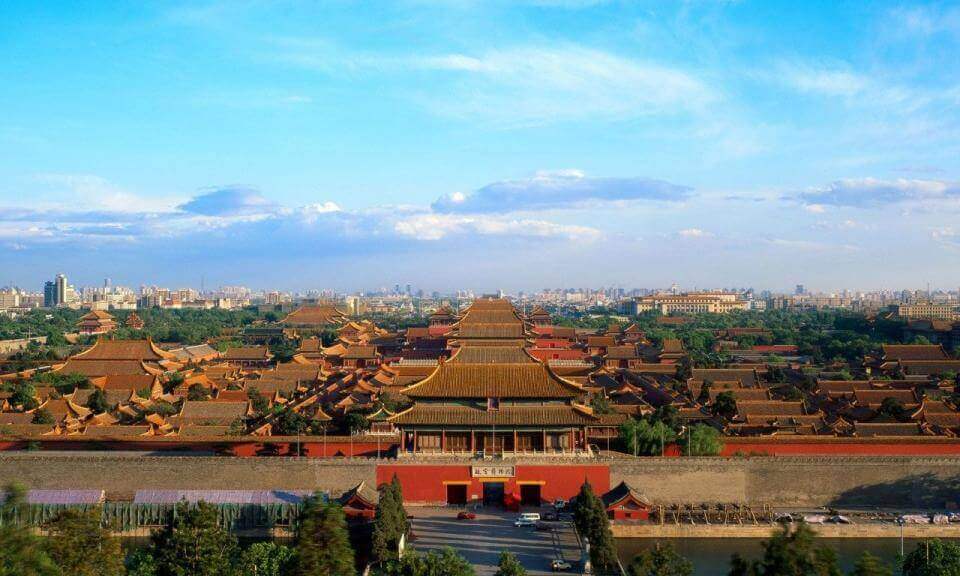 view of a large part of Beijing's Forbidden City from Jingshan Hill
view of a large part of Beijing's Forbidden City from Jingshan Hill
How to get to the Forbidden City in Beijing?
| Address: | Palace Museum, 4 Jingshan Street, Dongcheng district, Beijing, China |
| Tel.Nr.: | +86 10 8500 7421 |
| Airport: | Beijing Nanyuan Airport (NAY), Beijing Capital International Airport (PEK), Beijing Daxing International Airport (PKX) |
| Train Station: | Beijing Railway Station, Beijing South Railway Station, Beijing West Railway Station, Beijing North Railway Station, Beijing East Railway Station, Qinghe Railway Station |
| Metro: | Tiananmen East Station - Subway Line 1 - Exit A; Tiananmen West Station - Subway Line 1 - Exit B; Qianmen Station - Subway Line 2 - Take Exit A and then walk northward |
| Bus: | Tiananmen East Station (bus lines: 1, 2, 52, 59, 82, 120, Sightseeing Bus Line 2, Tourist Bus Line 2); Tiananmen West Station (bus lines: 1, 5, 52, Sightseeing Bus Line 1, Sightseeing Bus Line 2, Tourist Bus Line 2) |
At the center of the following Google map, you can see the location of the Palace Museum (the blue icon). The yellow hotel bed icon marks the location of the Beijing Hotel NUO which is our recommended hotel nearby. Further below on this page, you can read a review of this hotel's services and amenities. In case you are planning a trip to China, you could support this website by using the provided affiliate links to check prices and book your hotel accomodation!
You can book hotels in China with both of our affiliate partners Agoda and Trip.com. No matter whether you choose Agoda or Trip.com, you will find many offers on each of these platforms that will allow you to make a risk-free booking with the possibility of free cancellation until a clearly stated date and time, sometimes as late as on the intended date of arrival. However, some deals require prepayment and don't permit cancellation without fees. In that case, the incurred cancellation fees are clearly stated.
When following an Agoda link, the search results will show you prices, availability and special offers for your chosen dates with the recommended hotel in the top search position as well as for other hotels in the same area. Links to Trip.com will take you to the specific hotel webpage where you can then search for availability, prices and special deals with your chosen dates.
The provided information was thoroughly researched from various hotel booking websites. Chinese History Digest is not responsible if any information regarding the provided services and amenities might have changed.
Recommended Hotel near the Palace Museum
The Beijing Hotel NUO that is reviewed below is one of the closest 5-star hotels to the Palace Museum in Beijing. In addition to the links to Agoda that are used in the review below, this hotel is also available for booking on Trip.com by following this link.
Beijing Hotel NUO
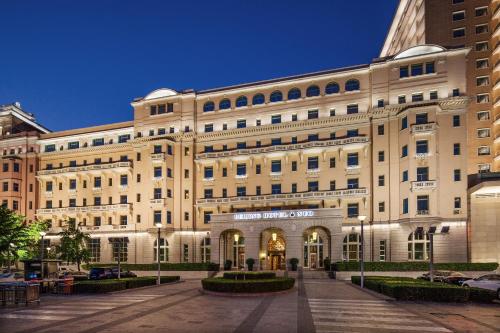 The Beijing Hotel NUO is a 5-star hotel that occupies Block B (built in 1917) of the historic Beijing Hotel. With its classic architecture that attracts attention with its grand colonnade façade, broad marble staircase and interior features such as period-styled rooms and polished 1920s dance floor, this hotel attracts travellers from all over the world that want to experience its mixture of old-world charm and modern comforts (last hotel renovation was in 2006). When it comes to location-related advantages, there is also no better place to stay in Beijing than at the Hotel NUO. It is located right at the heart of the city within walking distance of the Forbidden City and just a few minutes walk away from the Wangfujing Subway Station as well as the famous Wangfujing Street (famous for shopping and eating). What's more, access to the neighborhoods around the hotel is greatly facilitated by the availability of a free shuttle service. Of course, the hotel also arranges transportation to and from the airport (for an extra fee of 750 yuan) and guests can request to book that service in advance when making their room reservation online. Travel time between the hotel and the closest airport - Beijing Capital International Airport (PEK) - is typically about 50 minutes.
The Beijing Hotel NUO is a 5-star hotel that occupies Block B (built in 1917) of the historic Beijing Hotel. With its classic architecture that attracts attention with its grand colonnade façade, broad marble staircase and interior features such as period-styled rooms and polished 1920s dance floor, this hotel attracts travellers from all over the world that want to experience its mixture of old-world charm and modern comforts (last hotel renovation was in 2006). When it comes to location-related advantages, there is also no better place to stay in Beijing than at the Hotel NUO. It is located right at the heart of the city within walking distance of the Forbidden City and just a few minutes walk away from the Wangfujing Subway Station as well as the famous Wangfujing Street (famous for shopping and eating). What's more, access to the neighborhoods around the hotel is greatly facilitated by the availability of a free shuttle service. Of course, the hotel also arranges transportation to and from the airport (for an extra fee of 750 yuan) and guests can request to book that service in advance when making their room reservation online. Travel time between the hotel and the closest airport - Beijing Capital International Airport (PEK) - is typically about 50 minutes.
All rooms of the Beijing Hotel NUO are air-conditioned and contain a refrigerator, minibar and safe. Free bottled water is provided. Guests have free internet access through Wi-Fi and LAN cable. In addition to standard rooms, the hotel also has family rooms and suites (incl. a bridal suite). Smoking is only allowed in certain designated areas of the hotel (so not inside the rooms)! Laundry service (including dry cleaning) and luggage storage are available. There are three restaurants on-site (plus a bar and a coffee shop) where award-winning chefs prepare gourmet food in a variety of different cuisines. Guests also have manifold choices regarding which type of breakfast they prefer (American, Asian, Continental, Vegan, Buffet). Most room rates include breakfast which can also be purchased separately for 178 yuan if not included. To keep in shape, guests can exercise at the hotel's modern fitness center with its state-of-the-art exercise equipment and enjoy themselves at the hotel's indoor swimming pool.
0.8 miles away
Check availability & prices!